What You Will Learn
• On-premises call control
• Managed customer-premises equipment (CPE) services
• Fully hosted unified communications
• Collaboration-as-a-service (CaaS)
• Hybrid model
Figure 1. There Is Growing Interest in Managed Service Deployment Models
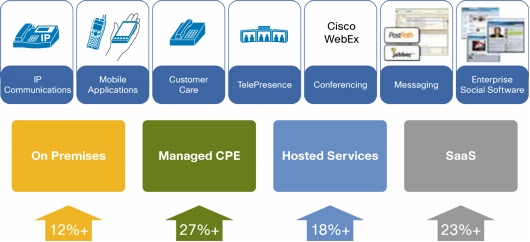
Despite Budget Constraints, Unified Communications Implementation Is Proceeding
Growing Interest in Managed Services
• Reduce capital expenditures (CapEx)
• Lower operating expenses (OpEx) and total cost of ownership (TCO)
• Enable faster time-to-market
• Mitigate technology risk and avoid obsolescence
• Lower carbon footprint and power needs
• Enable companies to flexibly scale up and down
• Choose hosted collaboration services, letting their provider host dedicated equipment for their organization
• Follow the managed CPE model, in which they would buy the equipment and keep it on site but have a service provider manage it
• Opt to pay a license fee and have collaboration services delivered by a service provider over the cloud
Figure 2. CIOs Discuss Outsourcing in Cisco Blind Focus Groups
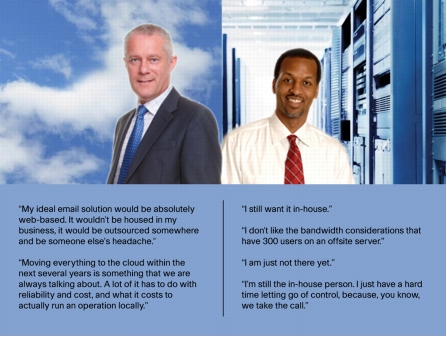
The Importance of an Open, Interoperable Approach

• CPE, in which the customer owns and manages the hardware and software
• Managed CPE services, in which the customer owns the solution, but the service provider manages it
• Fully hosted unified communications, in which the service provider hosts dedicated equipment within its network operations center (NOC) for a predictable monthly cost
• CaaS, or managed cloud services, in which the service provider or system integrator maintains and owns the software, which is delivered over the cloud, and the customer pays a license fee to use it
• Hybrid or blended model, that has a mix of on-premises and managed services

Which Deployment Option Is Right for Your Business?
• If your company views technology as a competitive differentiator: The traditional CPE model is ideal for you if technology is a strategic part of your value proposition and you want to do handle everything yourself. You purchase and integrate the tools and build the knowledge, skills, and processes to manage your converged network and the new unified communications and collaboration solutions that run on it. Your IT staff, in essence, becomes a service provider for your organization.
• If your company wants to focus less on IT and more on core competencies: Managed CPE is something you should consider if you want to own the unified communications infrastructure and software, but you want your IT staff to be able to take on other strategic initiatives, or your IT staff is lacking the required expertise. A service provider with unified communications and collaboration expertise can help you transform your organization and lower your OpEx because the service provider manages the hardware and software. This arrangement eliminates on-premises management and maintenance costs such as full-time help desk and server support, freeing your IT staff to focus on other tasks.
• If your company in a hurry and is risk averse: Fully hosted unified communications may be the deployment model for you if you want to build competitive advantage with leading unified communications and collaboration technologies fast, but you are unsure that your IT staff can handle an enterprisewide initiative. You'll have all the benefits of unified communications with none of the capital outlays and IT support (Figure 3).
When the service provider purchases and hosts dedicated hardware and software, you can take full advantage of the benefits of unified communications without the upfront capital equipment and licensing costs of installing the applications on site. Your service provider handles it all. You have to deal with only one supplier, one bill, and one help desk for your telephony and unified communications needs.
Hosted unified communications also mitigates risk and allows you to concentrate on differentiating your core business from your competitors'. All these benefits are provided for a predictable per-user, per-month fee that becomes a standard business expense.
Figure 3. Hosted Unified Communications System
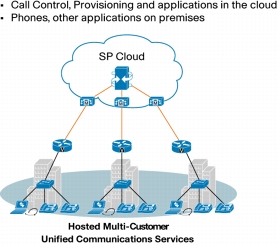
• If your company is CapEx-constrained and uncertain about the future: Consider CaaS if, like many companies today, you need to do more with less: fewer people, less budget, and less lead time. A software-based delivery model provides unified communications and collaboration services through private clouds. Cloud services deliver rapid time-to-value and are typically paid for as they are used - some providers bill by the second - and you pay for only the required capacity and features. This utility-based pricing model eliminates the cost of directly buying, installing, and maintaining the needed hardware and software (Figure 4).
With CaaS, your company can quickly scale the benefits of unified communications and collaboration across the enterprise and then scale down, depending on your needs, all without your having to manage the infrastructure. CaaS, or managed cloud services, offers the potential to provide the same level of support for converged applications as a CPE solution. CaaS is also a green deployment model, not only because collaboration technologies reduce travel, but also because your company will not be increasing its carbon footprint.
One potential drawback to the CAAS model is that the service provider determines the capabilities, so you may not have all the features available to you that you would if you owned and managed the system yourself. However, if you work with a systems integrator, you can have input into functions.
Figure 4. Web Conferencing in the Cloud and Audio Conferencing on Premises
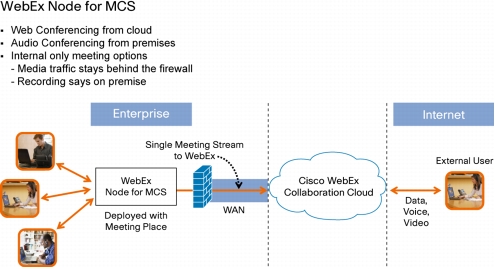
• If your company is seeking investment protection and flexibility: A blended or hybrid model may be your best option if you have older private branch exchange (PBX) and IP equipment and want to introduce new unified communications and collaboration capabilities without introducing more complexity for your IT staff. With an open and interoperable platform, you can use cloud and premises benefits for particular components. Blended models also help ensure state-of-the-art capabilities because solution providers typically use the most current versions of software and hardware.
You can integrate standalone applications across departments (federation) even if other departments have different deployment models. You can deploy some applications on premises and some in the cloud, working together (application integration), You can also take functions of the same applications and deploy some in cloud and some on your premises (componentization); for example, presence federation can be enabled between on-premises and cloud-delivered unified communications (Figure 5). More important, you can evolve your blended deployment model as your needs evolve and change or as new collaboration technologies become available.
Figure 5. Presence Federation
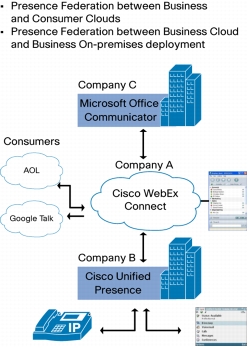
Figure 6. Intercompany Telepresence
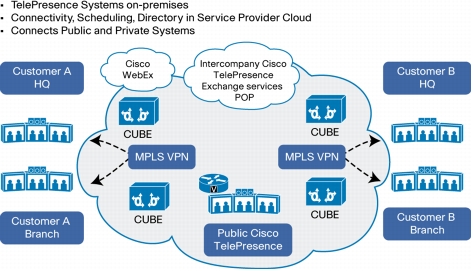
Wide Range of Unified Communications and Collaboration Applications
• Basic services: IP dial tone, voicemail, basic mobility, and audio conferencing
• Advanced services: Web collaboration, unified communications (for example, instant messaging, presence, and enhanced telephony), unified messaging, and autoattendant
• Premium services: Mobile collaboration, business-to-business collaboration, telepresence, communication-enabled business processes, and customer care with self-service and intelligent routing
• Network-designated service provider powered by Cisco products:
– Cisco Hosted Collaboration Solution (Cisco HCS). Cisco HCS is an offering that allows Cisco partners to provide a wide range of Cisco collaboration applications to their customers in a subscriber-based, "as a service "offer. For end-user organizations, the Cisco Hosted Collaboration Solution provides exceptional flexibility in choosing the way that collaboration applications are deployed. The capability to choose a hosted deployment option can also help customers deploy collaboration technologies faster while potentially lowering capital expenditures (CapEx) and operating expenses (OpEx). The Cisco Hosted Collaboration Solution is built on these four pillars:
Cisco Unified Communications and Collaboration: Cisco Unified Communications System 8.0 offers the industry's broadest portfolio of applications and capabilities. The Cisco Hosted Collaboration Solution makes this portfolio available in a hosted environment.
Optimized Virtualization Platform: This is based on Cisco Unified Computing System (UCS), a next -generation integrated data center system that simplifies operations. The Cisco Unified Communications Hosted System has been optimized to run on UCS and can improve performance, lower the cost of ownership, and increase operational productivity.
Centralized Management: This environment is centered on operational efficiency, from initial implementation and services activation to ongoing provisioning, including moves, adds, and changes.
Service Provider System Architecture: This aggregation layer is designed to integrate into a service provider's environment, specifically, into the carrier-grade network infrastructure of applications, tools, and components.
– Dubai service provider, du, offers bundled packaged services to meet the IP communications needs of small to medium-sized businesses (SMBs). Its hosted voice service provides functions equivalent to those of a traditional PBX, including features such as multiparty call conferencing, extension mobility, voicemail, call forwarding, call waiting, and music on hold. Companies pay by the second on all calls, with free local calls and up to 50 percent savings on all international calls.
– AT&T offers a fully managed, ready-to-use managed telepresence service that provides business-to-business telepresence in (23 countries), allowing companies to eliminate place-to-place meetings with face-to-face meetings regardless of geography.
– British Telecom (BT) now provides global cloud-based, hosted unified communications services. BT's new cloud-based services free valuable IT resources to focus on strategic business priorities, while enabling organizations to retain the capability to quickly switch on new productivity-enhancing collaborative communications technologies, such as application sharing, messaging, and conferencing. A feature-rich web portal allows companies to reconfigure users' phones, set up phones for new staff members, and manage name and number displays. Extension mobility features make it possible for users to log in at any phone and have their full profile and settings available, anywhere in the world.

Conclusion
• Own and manage systems in-house
• Own the system but have a service provider manage it
• Have a managed service provider purchase dedicated equipment and host it
• Have the service provider or system integrator deliver unified communications services over the cloud
• Use a blended model that provides the best of all deployment options
For More Information